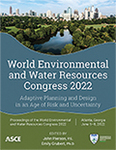Optimal Control of Chlorine Concentration in Water Distribution System
Publication: World Environmental and Water Resources Congress 2022
ABSTRACT
Supplying high-quality water is the key task of water distribution systems (WDSs). Although in Germany and some other countries chlorine is no longer used, it remains as a major disinfectant in WDSs worldwide. Therefore, chlorine concentration represents an important parameter for determining the water quality; that is, we should ensure the chlorine concentration within a reasonable range in a WDS. However, due to the complexity of the network structure and nonlinear behavior of the system, the control of chlorine concentration in WDSs imposes a challenging task. In this study, a model-based optimal control strategy is developed to address this problem. The mass and energy conservation laws are used to describe the hydraulic properties of WDSs. The one-dimensional advective transport model is simplified to describe the decay of chlorine in the pipelines. The chlorine concentration limits at the nodes are formulated as inequality constraints which will be satisfied by manipulating the flows and their directions in the pipelines. As a result, a nonlinear optimization problem is formulated and solved to achieve the specified chlorine concentration. For verifying our approach, we deliver the computed results for benchmark networks as input to the simulation model in EPANET, and the simulation gives satisfactory values of the specified chlorine concentration in the network.
Get full access to this article
View all available purchase options and get full access to this chapter.
REFERENCES
Abraham, E., Blokker, M., and Stoianov, I. (2018). Decreasing the Discoloration Risk of Drinking Water Distribution Systems through Optimized Topological Changes and Optimal Flow Velocity Control. Journal of Water Resources Planning and Management. 144. https://doi.org/10.1061/(ASCE)WR.1943-5452.0000878.
Constans, S., Bremond, B., and Morel, P. Simulation and control of chlorine levels in water distribution networks. ASCE Journal of Water Resources Planning and Management, 129:135–145, 03 2003.
Currie, J., and Wilson, D. Opti: Lowering the barrier between open source optimizers and the industrial matlab user. 01 2012.
Eliades, D. G., Kyriakou, M., Vrachimis, S., and Polycarpou, M. M. (2017, March 23). EPANET-MATLAB Toolkit: An Open-Source Software for Interfacing EPANET with MATLAB. Computer Control for Water Industry (CCWI).
Kourbasis, N., Patelis, M., Tsitsifli, S., and Kanakoudis, V. Optimizing water age and pressure in drinking water distribution networks. Environmental Sciences Proceedings, 2:51, 09 2020.
Kadinski, L., Schuster, J., Abhijith, G. R., Cao, H., Grieb, A., Li, P., Ernst, M., and Ostfeld, A. Establishing an experimental and simulation interface for online monitoring and modelling of bacterial growth in water distribution systems. Submitted to: EWRI Proceedings, 2022.
Lansey, K., Pasha, F., Pool, S., Elshorbagy, W., and Uber, J. Locating satellite booster disinfectant stations. Journal of Water Resources Planning and Management, 133:372–376, 2007.
Pecci, F., Abraham, E., and Stoianov, I. Penalty and relaxation methods for the optimal placement and operation of control valves in water supply networks. Computational Optimization and Applications, 67, 05 2017.
Pecci, F., Stoianov, I., and Ostfeld, A. Tightened polyhedral relaxations of a non-convex mixed integer program for optimal placement and control of valves and chlorine boosters in water networks. 07 2020.
Rossman, L., et al. Epanet users manual. 1994.
Rossman, L., Boulos, P., and Altman, T. Discrete volume-element method for network water-quality models. ASCE Journal of Water Resources Planning and Management, 119:505–517, 09 1993.
Schuster, J., Kadinski, L., Cao, H., Abhijith, G. R., Grieb, A., Li, P., Ostfeld, A., and Ernst, M. Real-time monitoring and controlling of water quality in water distribution networks based on flow cytometry and fluorescence spectroscopy. Submitted to: EWRI Proceedings, 2022.
Waechter, A., and Biegler, L. On the implementation of an interior-point filter line-search algorithm for large-scale nonlinear programming. Math- ematical programming, 106:25–57, 03 2006.
Information & Authors
Information
Published In
History
Published online: Jun 2, 2022
Authors
Metrics & Citations
Metrics
Citations
Download citation
If you have the appropriate software installed, you can download article citation data to the citation manager of your choice. Simply select your manager software from the list below and click Download.
